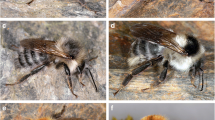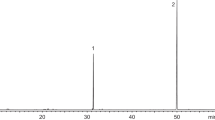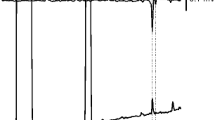Abstract
Studies of bumble bee male sex pheromones are often based on hexane extraction of cephalic labial gland secretions. Here, we propose an alternative extraction procedure based on whole head extractions. To test this method, we compared cephalic parts of the labial glands (CLG) to whole head extractions using high-sensitivity gas chromatography coupled to mass spectrometry (GC–MS) analysis. Two species were analyzed: Bombus terrestris dalmatinus and Bombus ignitus ignitus. We used correlation coefficients, cluster analysis and the two-group k-means method to test the similarity between the two extractions of the two species. We also used the indicator value (IndVal) method to characterize the indicator compounds of each procedure. Statistical analyses reveal a similar compound extraction using both methods. This simplified sample preparation gives reliable results and is more suitable for broad-scale sampling both by specialists and by amateur collectors. Using this method, we provide the first description of the male pheromonal secretions of B. ignitus ignitus and demonstrate that these secretions are very similar to the pheromonal blend of B. terrestris dalmatinus where 44/51 compounds are shared.




Similar content being viewed by others
References
Ågren L., Cederberg B. and Svensson B.G. 1979. Changes with age in ultrastructure and pheromone content of male labial glands in some bumble bee species (Hymenoptera, Apidae). Zoon 7: 1-14
Aytekin A.M., Terzo M., Rasmont P. and Çağatay N. 2007. Landmark based geometric morphometric analysis of wing shape in Sibiricobombus Vogt (Hymenoptera: Apidae: Bombus Latreille). Ann. Soc. entomol. Fr. (n.s.) 43: 95-102
Bagnères A-G. and Wicker-Thomas C. 2010. Chemical taxonomy with hydrocarbons. In: Insect Hydrocarbons - Biology, Biochemistry, and Chemical Ecology (Blomquist G.J. and Bagnères A-G., Eds), Cambridge University Press, New-York. pp 121-162
Bergström G. and Svensson B.G. 1973. 2,3-Dihydro-6, trans-farnesol: main component in the cephalic marker secretion of Bombus jonellus K. (Hym., Apidae) males. Zoon Suppl. 1: 61-65
Bergström G., Kullenberg B. and Ställberg-Stenhagen S. 1973. Studies on natural odoriferous compounds. VII. Recognition of two forms of Bombus lucorum L. (Hymenoptera, Apidae) by analysis of the volatile marking secretion from individual males. Chem. scripta 4: 174-182
Bertsch A. 1997. Abgrenzung der Hummel-Arten Bombus cryptarum und B lucorum mittels männlicher Labialdrüsen-Sekrete und morphologischer Merkmale (Hymenoptera, Apidae). Entomol. Gen. 22:129-145
Bertsch A., Schweer H., Titze A. and Tanaka H. 2005. Male labial gland secretions and mitochondrial DNA markers support, species status of Bombus cryptarum and B. magnus (Hymenoptera, Apidae). Insect. Soc. 52: 45-54
Blum M.S., Fales H.M., Morse R.A. and Underwood B.A. 2000. Chemical characters of two related species of giant honeybees (Apis dorsata and A. laboriosa): Possible ecological significance. J. Chem. Ecol. 26: 801-807
Bruschini C., Cervo R., Dani F.R. and Turillazzi S. 2007. Can venom volatiles be a taxonomic tool for Polistes wasps (Hymenoptera, Vespidae)? J. Zool. Syst. Evol. Res. 45: 202-205
Calam D.H. 1969. Species and sex-specific compounds from the heads of male bumblebees (Bombus spp.). Nature 221: 856-857
Cameron S.A., Hines H.M. and Williams P.H. 2007. A comprehensive phylogeny of the bumble bees (Bombus). Biol. J. Linnean Soc. 91: 161-188
Claudet J., Pelletier D., Jouvenel J.Y., Bachet F. and Galzin R. 2006. Assessing the effects of marine protected area (MPA) on a reef fish assemblage in a northwestern Mediterranean marine reserve: Identifying community-based indicators. Biol. Conserv. 130: 349-369
Coppée A., Terzo M., Valterová I. and Rasmont P. 2008. Intraspecific variation of the cephalic labial gland secretions in Bombus terrestris (L.) (Hymenoptera: Apidae). Chem. Biodivers. 5: 2654-2661
Dahbi A., Hefetz A. and Lenoir A. 2008. Chemotaxonomy of some Cataglyphis ants from Morocco and Burkina Faso. Biochem. Syst. Ecol. 36: 564-572
Dufrêne M. and Legendre P. 1997. Species assemblages and indicator species: the need for a flexible asymmetrical approach. Ecol. Monogr. 67: 346-366
Ellis J.S., Knight M.E. and Goulson D. 2005. Delineating species for conservation using mitochondrial sequence data: the taxonomic status of two problematic Bombus species (Hymenoptera: Apidae). J. Insect Conserv. 9: 75-83
Ellis J.S., Knight M.E., Carvell C. and Goulson D. 2006. Cryptic species identification: a simple diagnostic tool for discriminating between two problematic bumblebee species. Mol. Ecol. Notes 6: 540-542
Estoup A., Solignac M., Cornuet J.M., Goudet J. and Scholl A. 1996. Genetic differentiation of continental and island populations of Bombus terrestris (Hymenoptera: Apidae) in Europe. Mol. Ecol. 5: 19-31
Haverty M.I., Page M., Nelson L.J. and Blomquist G.J. 1988. Cuticular hydrocarbons of dampwood termites, Zootermopsis: Intra- and intercolony variation and potential as taxonomic characters. J. Chem. Ecol. 14: 1035-1058
Haverty M.I., Woodrow R.J., Nelson L.J. and Grace J.K. 2005. Identification of termite species by the hydrocarbons in their feces. J. Chem. Ecol. 31: 2119-2151
Ito M. 1987. Geographic variation of an eastern Asian bumble bee Bombus diversus in some morphometric characters (Hymenoptera, Apidae). Kontyu 55: 188-201
Kanbe Y., Okada I., Yoneda M., Goka K. and Tsuchida K. 2008. Interspecific mating of the introduced bumblebee Bombus terrestris and the native Japanese bumblebee Bombus hypocrita sapporoensis results in inviable hybrids. Naturwissenschaften 95: 1003-1008
Kindl J., Hovorka O., Urbanová K. and Valterová I. 1999. Scent marking in male premating behavior of Bombus confusus. J. Chem. Ecol. 25: 1489-1500
Kondo N.I., Yamanaka D., Kanbe Y., Kunitake Y.K., Yoneda M., Tsuchida K. and Goka K. 2009. Reproductive disturbance of Japanese bumblebees by the introduced European bumblebee Bombus terrestris. Naturwissenschaften 96: 467-475
Kullenberg B., Bergström G., Bringer B., Carlberg B. and Cederberg B. 1973. Observations on scent marking by Bombus Latr. and Psithyrus Lep. Males (Hym., Apidae) and localization of site of production of the secretion. Zoon Suppl. 1: 23-30
Lucas C., Fresneau D., Kolmer K., Heinze J., Delabie J.H.C. and Pho D.B. 2002. A multidisciplinary approach to discriminating different taxa in the species complex Pachycondyla villosa (Formicidae). Biol. J. Linn. Soc. 75: 249-259
MacQueen J.B. 1967. Some Methods for classification and analysis of multivariate observations. In: Proc. 5th Berkeley Symp. Math, Statistics, and Probability, University of California Press. pp 281-297
Martin S.J., Helanterä H. and Drijfhout F.P. 2008. Evolution of species-specific cuticular hydrocarbon patterns in Formica ants. Biol. J. Linn. Soc. 95: 131-140
Murray T.E., Fitzpatrick U., Brown M.J.F. and Paxton R.J. 2008. Cryptic species diversity in a widespread bumble bee complex revealed using mitochondrial DNA RFLPs. Conserv. Genet. 9: 653-666
Paterson H.E.H. 1985. The recognition concept of species. In: Species and Speciation (Vrba E.S., Ed), Transvaal Museum Monograph No.4, Transvaal Museum, Pretoria. pp 21-29
Paterson H.E.H. 1993. Evolution and the Recognition Concept of Species. The Johns Hopkins University Press, Baltimore. 234 pp
R Development Core Team, 2009. R: A language and environment for statistical computing. R Foundation for Statistical Computing, Vienna, Austria. ISBN 3-900051-07-0, URL http://www.R-project.org.
Rasmont P., Terzo M., Aytekin A.M., Hines H., Urbanová K., Cahliková L. and Valterová I. 2005. Cephalic secretions of the bumblebee subgenus Sibiricobombus Vogt suggest Bombus niveatus Kriechbaumer and Bombus vorticosus Gerstaecker are conspecific (Hymenoptera, Apidae, Bombus). Apidologie 36: 571-584
Reynolds T. 2007. The evolution of chemosystematics. Phytochemistry 68: 2887-2895
Schlick-Steiner B.C., Steiner F.M., Seifert B., Stauffer C., Christian E. and Crozier R.H. 2010. Integrative taxonomy: a multisource approach to exploring biodiversity. Annu. Rev. Entomol. 55: 421-438
Šobotnik J., Kalinová B., Cahliková L., Weyda F., Ptáček V. and Valterová I. 2008. Age-dependent changes in structure and function of the male labial gland in Bombus terrestris. J. Insect Physiol. 54: 204-214
Svensson B.G. 1979. Pyrobombus lapponicus auct., in Europe recognized as two species: P. lapponicus (Fabricius, 1793) and P. monticola (Smith, 1849) (Hymenoptera, Apoidea, Bombinae). Insect Syst. Evol. 10: 275-296
Svensson B.G. 1980. Species-Isolating Mechanisms in Male Bumble Bees (Hymenoptera, Apidae). Acta Universitatis Upsaliensis, Uppsala. 42 pp
Svensson B.G. and Bergström G. 1977. Volatile marking secretions from the labial gland of north European Pyrobombus D. T. males (Hymenoptera, Apidae). Insect. Soc. 24: 213-224
Terzo M., Valterová I., Urbanová K. and Rasmont P. 2003. De la nécessité de redécrire les phéromones sexuelles des mâles de bourdons (Hymenoptera, Apidae, Bombini) publiées avant 1996 pour leur utilisation en analyse phylogénétique. Phytoprotection 84: 39-49
Terzo M., Urbanová K., Valterová I. and Rasmont P. 2005. Intra and interspecific variability of the cephalic labial glands’ secretions in male bumblebees: the case of Bombus (Thoracobombus) ruderarius and B. (Thoracobombus) sylvarum (Hymenoptera, Apidae). Apidologie 36: 85-96
Terzo M., Valterová I. and Rasmont P. 2007a. Atypical secretions of the male cephalic labial glands in bumblebees: The case of Bombus (Rhodobombus) mesomelas Gerstaecker (Hymenoptera, Apidae). Chem. Biodivers. 4: 1466-1471
Terzo M., Coppens P., Valterová I., Toubeau G. and Rasmont P. 2007b. Reduced cephalic labial glands in the male bumblebees of the subgenus Rhodobombus Dalla Torre (Hymenoptera : Apidae : Bombus Latreille). Ann. Soc. entomol. Fr. (n.s.) 43: 497-503
Williams P.H. 1998. An annotated checklist of bumble bees with an analysis of patterns of description (Hymenoptera: Apidae, Bombini). Bull. Nat. Hist. Mus. Lond. Entomol. 67: 79-152 [updated at http://www.nhm.ac.uk/entomology/bombus]
Williams P.H. and Hernandez L. 2000. Distinguishing females of the bumble bees Bombus ruderatus (F.) from Bombus hortorum (L.) in Britain: a preliminary application of quantitative techniques. In: Report to the UK Biodiversity Action Plan (Bumblebee working group). 25 pp
Žáček P., Kalinová B., Šobotnik J., Hovorka O., Ptáček V., Coppée A., Verheggen F. and Valterova I. 2009. Comparison of age-dependent quantitative changes in the male labial gland secretion of Bombus terrestris and Bombus lucorum. J. Chem. Ecol. 35: 698-705
Acknowledgments
We wish to thank BIOBEST bvba for providing the colonies used in this study, and S.D. Kocher and R. Shelby for editing help in English. We are also grateful to collectors and collaborators of the Laboratory of Zoology for their precious help. Financial support was granted by FRIA and FRFC. The MS laboratory acknowledges the “Fonds de la Recherche Scientifique (FRS-FNRS)” for its contribution to the acquisition of the Waters GCT Premier Mass Spectrometer. P.G. is a research associate at the FNRS.
Author information
Authors and Affiliations
Corresponding author
Rights and permissions
About this article
Cite this article
De Meulemeester, T., Gerbaux, P., Boulvin, M. et al. A simplified protocol for bumble bee species identification by cephalic secretion analysis. Insect. Soc. 58, 227–236 (2011). https://doi.org/10.1007/s00040-011-0146-1
Received:
Revised:
Accepted:
Published:
Issue Date:
DOI: https://doi.org/10.1007/s00040-011-0146-1




